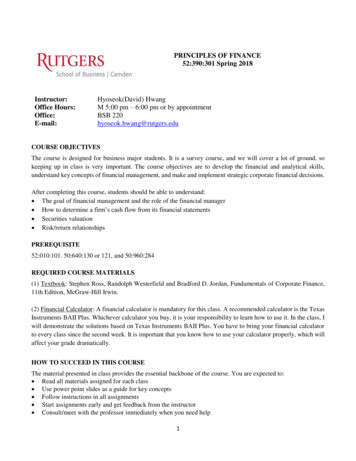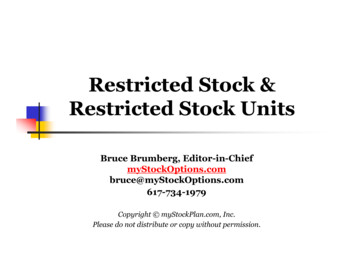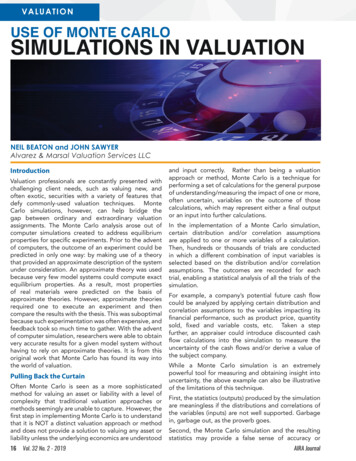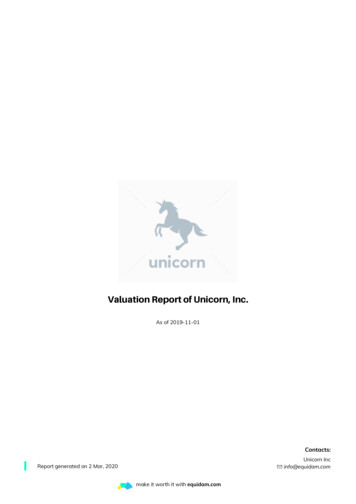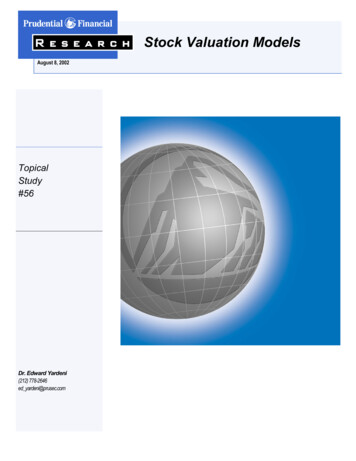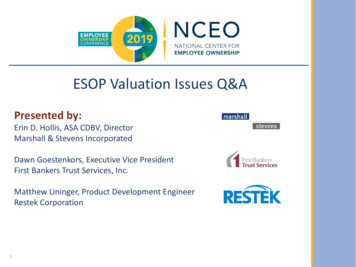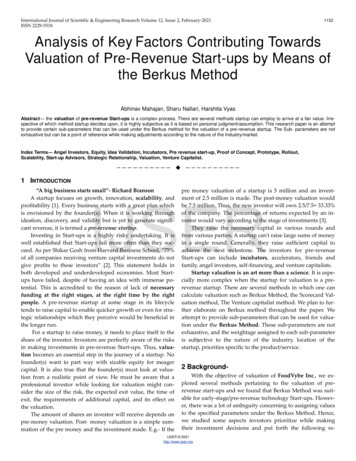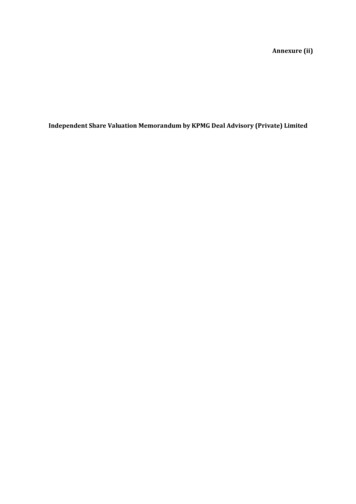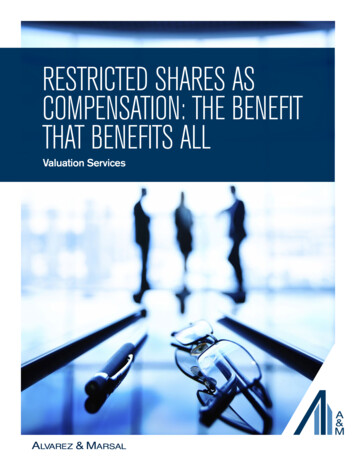
Transcription
RESTRICTED SHARES ASCOMPENSATION: THE BENEFITTHAT BENEFITS ALLValuation Services
VALUATION SERVICESRestricted Shares as Compensation:The Benefit that Benefits AllExecutive compensation continues to evolve, but the goals remain the same: align the incentives of the shareholderswith the executives. Financial engineering will progress in all areas, and executive compensation is not immune. Wehave seen complex incentive structures created to reward executives for specific performance or market-basedachievements. While these structures remain relevant and can be used to tailor an executive’s compensation, we havealso observed an increase of standard equity awards with post-vesting restrictions. In general, equity compensationis intended to align the objectives of shareholders and executives. The addition of post-vesting restrictions promotesexecutive retention and incentivizes stable long-term growth.The following benefits have encouraged the use of post-vesting holding requirements in restricted shares: Improved corporate governance Reduced compensation expenseThe benefits achieved are dependent on the restrictions and rights issued with shares. We will discuss the corporategovernance benefits that are achieved with lower compensation expense. The lower compensation expense is due tothe discounts in the valuation for the post-vesting restrictions. Corporate governance is enhanced, the company hasreduced expenses and the employee receives equity compensation, making restricted shares a benefit for all.IMPROVED CORPORATE GOVERNANCEExecutive compensation (as a percentage of corporate earnings) is at an all-time high and has been targeted bothpolitically and socially. Public companies are required to disclose executive compensation, allowing shareholders andthe general public to scrutinize executive rewards relative to performance. The pay-for-performance idea is not novel,yet it is challenging to implement. The issue is that value and performance are difficult to quantify and can also befleeting. In order to adjust for misaligned compensation and discourage the pursuit of short-term economic policies,companies have implemented time restrictions and clawback provisions for executive compensation. In the event ofpoor corporate governance, compensation adjustments can be executed to preserve an equitable arrangement.The Dodd-Frank Wall Street Reform and Consumer Protection Act of 2010 was established to protect investors.Final Securities and Exchange Commission (SEC) rules associated with the requirement for recovery mechanismshave not been finalized. Upon adoption, all listed companies will be required to incorporate effective compensationclawback policies.
The intent of corporate governance is to alignshareholders, Boards of Directors and executives towardcommon goals. Issuing restricted shares with timebased post-vesting restrictions and clawback provisionssupports strong corporate governance.REDUCED COMPENSATION EXPENSE FORFINANCIAL REPORTING PURPOSESThe potential benefit to the company issuing restrictedstock awards (RSAs) is primarily associated with thediscounts utilized when valuing post-vesting restrictions.ASC 718 and IFRS 2 Restricted Share Awards requirethe determination of fair value as of the grant date.Fair Value is defined as:The price that would be received to sell an asset or paidto transfer a liability in an orderly transaction betweenmarket participants at the measurement (valuation) date.The annual compensation expense for an RSA isdetermined by amortizing the grant date fair value overthe service period associated with the RSA (assumingan RSA is consistently rewarded with shares anduse of equity accounting). The grant date fair value isexpensed over the service period, but must considerthe discounts for any post-vesting restrictions in itsfair value determination. In general, time-based postvesting restrictions constrain the marketability of ashare, causing the share to be less desirable andvaluable to market participants. Careful considerationof these restrictions is essential, as discounts for lackof marketability (DLOM) generally range between 15percent and 35 percent, and often significantly impact acompany’s reported compensation expense.When determining if a mandatory post-vest holdingrequirement influences the award’s fair value, thefollowing criteria must be satisfied: The restrictions associated with a post-vest holdingrequirement must be attributes of the subject award.In other words, if award agreements include anabsolute prohibition on the post-vestment sale ofshares, a discount in consideration of this liquidityrestriction may be appropriate. Alternatively, a discountfor illiquidity cannot be applied to reflect restrictionsthat are ancillary to the equity award.
Discounts related to post-vesting time-based restrictionscan range from 15 percent to 35 percent. The restriction must represent an absolute prohibition on sale, rather than a limitation on an employee’s ability tosell the stock. For example, publicly traded companies sometimes issue shares of Rule 144 stock (or Letter Stock)that have not been SEC registered and impose an open market selling restriction of six-months from issuance.However, Rule 144 stock may be sold to qualified investors in a private transaction during this restriction period.The SEC contends that these constraints represent limitations on the ability, but not a full prohibition, of a sale andtherefore preclude the application of a DLOM.Standards boards, regulatory agencies and court opinions have provided the following guidance in support of theapplication of DLOMs.FASB (ASC 718) – “A restriction that continues in effect after an entity has issued instruments to employees, suchas the inability to sell vested shares for a period of time, is considered in estimating the fair value of the instruments atthe grant date.A share that will be restricted after the employee has a vested right to it, shall be measured at its fair value, which isthe same amount for which a similarly restricted share would be issued to third parties.”IASB (IFRS2) – “If the shares are subject to restrictions on transfer after vesting date, that factor shall be taken intoaccount, but only to the extent that the post-vesting restrictions affect the price that a knowledgeable, willing marketparticipant would pay for that share.”SEC (2007 remarks at AICPA conference) – “One common term we see in share-based payment arrangementsis a restriction that prohibits the transfer or sale of securities. If the security contains such a restriction that continuesafter the requisite service period, that post-vesting restriction may be factored as a reduction in the value of thesecurity The discount should be specific to the security and not derived based on general rules of thumb.”AICPA (2013 Guidance) – “There are many quantitative and qualitative methods for assessing a discount for lackof marketability. The most popular quantitative methods estimate the discount as a function of the duration of therestriction (time) and the risk of the investment (volatility). In most cases, the researchers developing each methodthen validated the results via a regression analysis using data from restricted stock studies.”IRS – “The IRS has published a work aid for its valuators to help them assess when a discount for lack ofmarketability is appropriate. They accept that when there is a significant reason to believe that both a buyer and sellerwould be willing to accept a lower price due to liquidity restrictions a DLOM is appropriate.”
Mandelbaum Case – Judge Laro’s methodology in Mandelbaum required valuation experts to consider thefollowing “factors influencing marketability” and the associated DLOM: Private vs. public sales of the stock Financial statement analysis Dividend policy Nature of the company: its history, industry position, economic outlook Company management Amount of control in the transferred shares Restrictions on transferability Holding period for the stock Company’s redemption policy Costs associated with a public offeringDiscounts may be appropriate based on the restrictions imposed and will vary from award to award. Valuationprofessionals must consider the factors above and choose a supportable valuation methodology to estimate a fair value.METHODS FOR QUANTIFYING THE IMPACT OF ILLIQUIDITYIf the aforementioned criteria have been met and application of a DLOM is warranted, then quantitative methods ofcalculating DLOMs and corroborative empirical data must be considered.Empirical evidence for a DLOM commonly considers observations of pre and post-IPO data and transactions inunregistered shares. In general, DLOMs are derived in consideration of changes in share price, with and without theassociated marketability discount. Pre-IPO shares are generally priced at a discount to post-IPO shares. Similarly,unregistered shares tend to sell at a discount relative to transactions post-restriction.Table 1 below illustrates the results of studies conducted by Emory & Co. on DLOMs implied by pre-IPO transactions.TABLE 1 PRE-IPO ILLIQUIDITY DISCOUNT STUDIES FROM EMORY & CO.TIME PERIODNUMBER OF OBSERVATIONSAVERAGE DISCOUNTMEDIAN 811360.00%66.00%All 9 Studies36346.90%46.60%
These studies primarily utilize exercise prices of employee stock options as a proxy for pre-IPO stock prices. Use ofthis proxy is imperfect at best and therefore the results of these studies, in isolation, may tend to overstate the DLOM.However, the empirical evidence suggests that pre and post-IPO prices support DLOMs approaching 50 percent.Empirical data derived from transactions of unregistered stock (Rule 144) can provide some evidence of DLOMs thatmay be applicable for restricted stock awards with post-vest holding requirements. Rule 144 allows companies thatdo not wish to pay the underwriting expenses for a secondary offering to issue unregistered shares in a transactioncalled a private investment in a public equity (PIPE). These shares are identical to publicly traded shares except thatthey have a selling restriction. The difference in price can be entirely attributed to a discount for illiquidity.There have been numerous studies of Rule 144 transactions that can help illustrate the DLOM implied by transactions ofstock having such liquidity restrictions.Table 2 below summarizes the results from 20 different studies conducted on PIPE transactions.TABLE 2 RULE 144 TRANSACTION STUDIES FROM MULTIPLE SOURCESSTUDY NAMETIME PERIODNUMBER OF OBSERVATIONSAVERAGE DISCOUNTMEDIAN DISCOUNTBajaj, Denis, Ferris and Sarin1990-19958822.20%--Bruce Johnson1991-19957220.00%--FMV Opinions Inc.1980-199724322.10%20.10%FMV Opinions Inc.1980-2005--22.00%---FMV Opinions Inc.1997-2005--21.60%FMV Opinions 4.60%Management Planning Inc.1980-200025927.40%24.80%Management Planning Inc.2000-20071,60014.60%--Michael Maher1969-19733435.40%33.00%Milton Gelman1968-19708933.00%33.00%Robert Moroney1968-197214635.60%33.00%SEC Institution Investor1966-196938925.80%23.60%Standard Research Consultants1978-198228--45.00%Trugman Valuation Associates2007-20088018.10%14.40%At inception, Rule 144 required a two-year holding period for shares issued in PIPE transactions. In 1997, the holdingperiod was reduced to one year, and then again in 2008 the holding period was reduced to the present day holdingperiod of six months. These studies encompass transactions that were subject to each of these three different holdingperiods. The DLOM shown from these studies that are more than five years in length has an approximate range of 15to 35 percent. As noted above, the discount realized on these shares can be entirely attributed to the risk associatedwith owning shares having a defined period of restriction.Regression analyses of these studies show that the length of the holding period and the observed price volatility areboth significant and positively correlated to the magnitude of the discount. These empirical studies are limited, onlyencapsulating data for transactions in which the holding period ranged from six months to two years. When supporting
a DLOM for shares having a range of volatilities andholding periods, it is necessary to apply a quantitativeapproach. Use of empirical studies should be limitedand only aid to corroborate quantitative determinationsof DLOM.In fact, the SEC has stated, “It is not enough to simplycite the average marketability discount used by yourinvestment banker or to highlight that the amount ofthe discount used falls within a broad range you notedin an academic study.”Discounts for lack of marketability can significantlyinfluence an RSA’s fair value determination andcorresponding compensation expense. Use of properlysupported discounts is acceptable and commonlyaccepted. However, derivation of supportablediscounts necessitates the use of quantitativemethods, as those solely predicated on empiricalstudies are commonly deemed unacceptable.COMMON QUANTITATIVE METHODSCost of Carry (Collared Strategy)This approach assumes that the discount for illiquidityis equivalent to the opportunity cost attributed toa hypothetical sale of the subject shares (absentrestrictions) and redeployment of capital proceeds inalternative investments. Under this assumption, thevalue of the DLOM is simply equal to the risk-freerate of return compounded annually, commensuratewith the holding period of the restricted shares.Although this calculation is easy to understand, ittends to have limited utility. This method ignores theeffect of volatility in assuming the holding sharescarry the same risk as the holding treasuries used inestablishing the risk-free rate of return. The DLOMconclusion on this approach understates the discountobserved in the empirical studies. Use of this approachshould be limited to shares having low price volatilityand long-term restrictions.
Chaffe Protective Put MethodThis model assumes the illiquidity discount is equalto the cost of an at-market put option, having acontractual term equal to the duration of the mandatorypost-vest holding period (Chaffe 1993), and basedon the premise that the put, once exercised, will yield100 percent liquidity. However, an at-the-money putprovides more value than just liquidity; it also provides alower bound for the share price, eliciting some criticismof this method. The model does produce liquiditydiscounts that are consistent with the observations ofDLOM from empirical studies when valuing shares withmoderate or low price volatility.Longstaff ModelThis model was developed to address some of theshortcomings of the protective put model. It centersthe cost of illiquidity on the end of holding periodvalue of a look-back option. A look-back optionallows the holder to sell the underlying stock at thepeak price during the restriction period. This modelestimates the maximum opportunity cost resultingfrom selling restrictions (Longstaff 1995). Althoughthis model eliminates the drawbacks of the Chaffemethod, it assumes the shareholder possesses theperfect market timing necessary to sell the subjectshares at their peak price during the holding period.As such, the Longstaff model tends to overstate theDLOM. This model tends to provide an upper boundfor DLOM and in our experience is not often used asthe sole quantitative approach.FinnertyThe Finnerty model assumes the cost of illiquidity isequal to the cost of an Asian Put Option (AverageStrike Price Option) having a strike price equal to theaverage stock price observed during the option term.The use of an Average Strike Price Option eliminatesthe assumption of perfect market timing inherent in
the Longstaff model, as well as the limitations integralwith the Chaffe method. However, this approach whenregressed against the qualitative studies tends tounderstate the discount for lower volatility stocks. Byvirtue of addressing common complaints associated withthe quantitative models cited above, the Finnerty modelis commonly used in practice to develop the illiquiditydiscount for post-vest holding restrictions on highvolatility stocks.SUMMARYBased on the current regulatory environment in which astrong corporate governance mandate is in the crosshairsof regulators, proxy advisors, investors and the generalpublic, we have seen increased use of post-vestingmandatory holding requirements and clawback terms.Companies and executives adopting these compensationplans can benefit. Effectively structured post-vest holdingperiods further bolster executive retention, and companyreported compensation expenses can potentially bereduced with proper consideration of discounts forlack of marketability. Properly structured compensationplans and rigorous application of appropriate valuationmethodologies will further enhance these results.Chief among these considerations is determiningthe appropriate discount for lack of marketability.When determining the appropriate methodology forquantifying DLOM, companies need to be cognizantof accounting and regulatory requirements. DLOMspredicated solely on qualitative considerations ofempirical studies are insufficient.Significant valuation expertise is necessary to properlyquantify a defensible DLOM. As the range of discountsderived from readily available transactions variessignificantly, DLOM conclusions can have a significantinfluence on fair value determinations and reportedcompensation expense.ABOUT THE AUTHORSChanduChilakapatiManaging Director 1 713 547 3647cchilakapati@alvarezandmarsal.comChandu Chilakapati is a Managing Director with Alvarez & MarsalValuation Services in Houston. He specializes in fair value accountingof financial instruments and financial reporting related to derivativeand hedge accounting, as well as traditional business and assetvaluation advisory services. Mr. Chilakapati has provided valuationand risk management consulting services for more than 13 years.During that time, he has provided fair values to corporate clientson thousands of instruments ranging from swaps to exotic optionsacross energy, interest rate and foreign currency underlying markets.He focuses on the energy sector and has delivered valuation reportsrelated to purchase price allocations, stock based compensation,energy derivative valuations, hedge accounting and tax valuations.AndrewGalbraithDirector 1 713 547 3635agalbraith@alvarezandmarsal.comAndrew Galbraith is a Director with Alvarez & Marsal ValuationServices in Houston. He has more than 17 years of experience inproviding fair value opinions for financial reporting, including ASC805 (business combinations), ASC 350 (intangibles, goodwill andother indefinite-lived assets) and ASC 360 (long-lived assets);valuation of intellectual assets; corporate value consulting; andlitigation support. Mr. Galbraith has valued intellectual propertyand businesses for tax purposes, including intellectual assetmanagement, donations, capital budgeting, litigation and arbitration.OTHER CONTRIBUTING AUTHORSBrian CumberlandJ.D. IvyRaj ChilakapatiA&M VALUATION SERVICESA&M Valuation Services is a full-service valuation practice withextensive knowledge and experience conducting energy industryvaluations for U.S and international financial reporting, tax, litigationand due diligence. Our experienced team and hands-on cultureof client service differentiates A&M. We solve complex valuationproblems for our clients and work with them from execution throughtheir financial reporting process.
ABOUT ALVAREZ & MARSALLEADERSHIP.PROBLEM SOLVING.VALUE CREATION.Follow us on:Companies, investors and government entities around theworld turn to Alvarez & Marsal (A&M) when conventionalapproaches are not enough to activate change and achieveresults. Privately-held since 1983, A&M is a leading globalprofessional services firm that delivers performanceimprovement, turnaround management and businessadvisory services to organizations seeking to transformoperations, catapult growth and accelerate results throughdecisive action. Our senior professionals are experiencedoperators, world-class consultants and industry veteranswho draw upon the firm’s restructuring heritage to helpleaders turn change into a strategic business asset,manage risk and unlock value at every stage.To learn more, visit www.alvarezandmarsal.com
Trugman Valuation Associates 2007-2008 80 18.10% 14.40% At inception, Rule 144 required a two-year holding period for shares issued in PIPE transactions. In 1997, the holding period was reduced to one year, and then again in 2008 the holding period was reduced to the present day holding period of six months.
